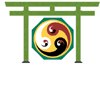
A Book of Little Traditions

|
minzoku NEO-shintô A Book of Little Traditions |
|
|
ToC |
||
|
tôja (Shrine Buildings) – 03 / 29 / 2016
tô (public chamber, hall)
ja (cottage, hut, house, inn, mansion) ❖ large and small buildings, esp. shrines and temples ❖ Also pronounced dôsha, dôja
chi (thousand)
gi | ki (tree, wood) chi (know, wisdom) gi | ki (tree, wood) chin (tranquilize, ancient peace-preservation centers) gi | ki (tree, wood) ❖ Forked roof finials found in shintô shrines ❖ Usually, horizontal to the ground ends indicate the enshrined kami is female ❖ Usually, vertical to the ground ends indicate the enshrined kami is male ❖ Also called okichigi
oki (placement, put, set, keep)
chi (thousand) gi | ki (tree, wood)
hai (worship, adore, pray to)
den (hall, mansion, palace, temple) ❖ Front shrine, hall of worship ❖ Public accessible
hei (cash, gift, Shinto offerings of cloth, rope, cut paper)
den (hall, mansion, palace, temple) ❖ Hall of offerings ❖ Connects the haiden and honden
hon (main, true, real)
den (hall, mansion, palace, temple) ❖ Main shrine, inner sanctuary ❖ Contains the shrine's shintai ❖ Normally not accessible
kagu | kami (that which inspires feelings of reverence, awe, gratitude, fear/terror)
ra (music, comfort, ease) kagura (ancient shintô music and dancing) den (hall, mansion, palace, temple) ❖ kagura hall (at a shrine) ❖ Also called kaguradô
kagu | kami (that which inspires feelings of reverence, awe, gratitude, fear/terror)
ra (music, comfort, ease) kagura (ancient shintô music and dancing) dô (public chamber, hall)
katsu | kata (strict, hard, solid, tough, tight, reliable)
uo (fish) gi | ki (tree, wood) katsuo (bonita) gi | ki (tree, wood) ❖ Log on the roof of a shrine set perpendicular to the ridgepole ❖ Originally functioned to help hold down thatched roof
koma (Korean)
inu (dog) koma inu (Korean dog) ❖ A pair of animals that protect the entrance to shrines and temples from evil ❖ Most commonly found are Korean dogs, Chinese lions, or kitsune ❖ One male with open mouth located on the left side of the entrance; sometimes called kara shishi ❖ And one female with mouth closed located on the right side of an entrance; sometimes called koma inu ❖ The open mouth represents 'a' – the beginning of the Japanese syllabary or yô – the yang principle ❖ The closed mouth represents 'n' – the end of the Japanese syllabary or in – the yin principle ❖ Also called shishi, kara shishi
shi (lion)
shi (child) shishi (lion) shi (expert, teacher, master, army, war) shi (child) shishi (lion) kara (China) shi (lion) shi (child) shishi (lion)
san (going, coming, visiting, visit)
dô (road-way, street) ❖ Road approaching a shrine ❖ Visitors to the shrine should walk along the edges of the road; the center is reserved for the kami
ses | setsu (surrogate, act in addition to)
sha (shrine) ❖ An auxiliary shrine (dedicated to a kami closely related to that of a main shrine) ❖ Also called massha
mas | matsu (close)
sha (shrine) ❖ Subordinate shrine
sha (office, company, firm, association, shrine)
mu (task, duties) sho (place) ❖ Office for running the shrine ❖ Usually also include a storefront for dispensing shinsatsu, offices where worshipers may apply for the performance of special rituals, residential areas where priests may retire for purification, and meeting rooms where ujiko may gather for naorai
tama (jewel, ball)
gaki (fence, hedge, wall) ❖ Fence around a shrine
te- (hand)
mizu (water) ya (roof, house) ❖ A font to allow shrine visitors to rinse hands and mouth in symbolic purification – misogi ❖ Also called chôzuya
chô (hand)
zu (water) ya | sha (hut)
tori (bird)
i (reside, to be, exist, live with) ❖ (Literally: bird perch) ❖ Sacred gateway ❖ shintô shrine archway ❖ Traditional Japanese gate usually found at the entrance of or within a shintô shrine ❖ Consists of two uprights with either a rope strung between, or one or two crossbeams
tô (lamp, a light, light, counter for lights)
rô (cage, coop) tô (lamp, a light, light, counter for lights) rô (basket, cage, coop) tô (lamp, a light, light, counter for lights) rô (spelled with hiragana) tô (nonstandard for J825: associated with light / ateji??) rô (basket, cage, coop) ❖ Garden lantern, hanging lantern |
||||||||||||||||||||||||||||||||||||||||||||||||||||||||||||||||||||||||
|
|